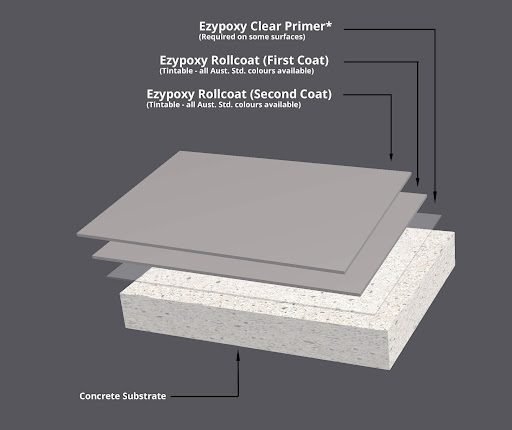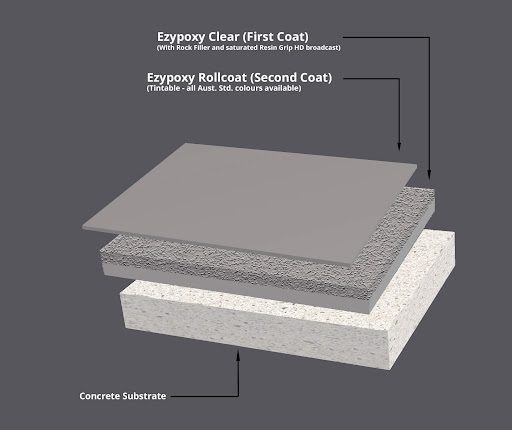
Epoxy commercial floors can come in many forms: thin roll-coat coatings, thick trowel-down coatings, self-level coatings, clear coatings,
pigmented coatings etc.
With such a great variety available, they’re naturally used to perform a whole host of roles in commercial areas. Protective
flooring systems and
non-slip flooring systems are well-known and attract most of the
attention from a commercial flooring perspective, however there are a few more reasons why epoxy flooring gets used that aren’t as
widely known.
Below we explore three incentives for epoxy commercial flooring that perhaps don’t get as much recognition.
The reasons why concrete floors dust vary with age. For new concrete, the biggest source is a fine, loose by-product of the hardening
process called laitance; for older slabs, abrasive traffic is the main problem.
The problem with concrete dust is how fine it is and, therefore, its uncanny ability to get everywhere! It can contaminate and damage all sorts of valuable commercial items: food, stock, electrical gear...the list goes on. It’s also quite tricky to clean up and very abrasive, which may cause trouble in other sensitive areas, including human lungs for example (read our separate post on respirable crystalline silica and silicosis). With consequences like these, you can see why dust-proofing commercial floors with epoxy flooring is a good move in many cases.
Left in its natural, open state, a concrete floor acts pretty much like a giant sponge; whatever spills onto the surface will quickly
absorb into the slab and be very tricky to remove. This characteristic is bad news for commercial floors on a couple of levels.
Firstly, the “one-two” punch of rapid staining and stubborn removal is a blow to your hopes of maintaining a pristine floor.
Everyone’s seen the dark, dingy workshop with oil stains, however the scary part is that it doesn’t need black gunk to look
bad. Just about any liquid will soak into concrete and create a colour difference that’s hard to ignore.
Secondly, by trapping all sorts of grime and moisture, concrete pores provide the perfect breeding ground for bacteria and mould. This can be a health concern for anyone exposed long enough and clearly unacceptable for food processing facilities, hospitals and other sensitive commercial floors.
With the help of epoxy coatings, a commercial floor can play an active role in making life easier and safer. The most common example is non-slip
epoxy flooring,
however epoxy flooring can also improve safety by enhancing visibility and communicating instructions to workers. Bright line marking
and colour coding that clearly defines steps, thoroughfares and danger zones are universal features on workshop and factory floors for
that very purpose. The visibility benefits also extend to the quick detection of spills and other slip hazards. A spill partially soaked
up by dirty, dull concrete floor will be much harder to deal with than one sitting on top of an impermeable, easy-to-clean surface.
It may come as a surprise to some to hear comfort thrown into this mix as well, however it’s a very real thing. Ask any factory worker who’s on their feet all day in the middle of winter and they’ll tell you commercial floors covered with epoxies can make a big difference to the draught chill factor. They’ll also probably tell you that putting down a protective epoxy flooring system, even a plain colour, can lighten and brighten a workplace considerably.
While commercial flooring can involve a number of different types of epoxy products and systems, the bread and butter of every installer in the commercial flooring field is a good epoxy rollcoat.
Using any old epoxy rollcoat for your commercial flooring projects may seem like a good way to save a bit of cash or use up old stock in some cases, but it can also come back to bite you. The truth is if you want to put down consistently high-quality commercial floors, you’ve got to use a quality epoxy rollcoat.
Here are five questions that are helpful to ask when trying to find the right one for the commercial floors you do.
While you can read more about the various differences between solvent-borne
and water-borne rollcoats compared to solventless
in a separate know how post, the one thing I want to highlight when it comes to commercial flooring is open time. When using
water-borne or solvent-borne coatings across large commercial floors, you want to make sure you can roll it out and keep the wet edge fresh
otherwise you can end up noticeable colour differences at the seams. The open time becomes even more important if using these types of
products for flake finishes, as broadcasting after the films have flashed off can lead to patchiness and bald spots (where the flake hasn’t
stuck). Solventless epoxy rollcoats have an advantage here because you’ve got extra time up your sleeve to get an even film and do
extra tasks like broadcasting.
For a 100% solids epoxy rollcoats in particular, it pays to understand what type of hardener is used. While IPD-based products are
popular for their low viscosity and low cost, they can be inconsistent and I’ve heard many stories about them misbehaving with amine
blush
and other potential problems. Commercial floors frequently come with short, high-pressure shutdowns, so it comes in very handy if your
epoxy rollcoat has a bit more tolerance of temperature and humidity and can perform even when applied in conditions that
aren't ideal.
While you want something that rolls out easily, the common practice of putting pigment into a clear
epoxy resin isn’t
ideal for commercial flooring. This type of rollcoat not only struggles with coverage and colour separation, it can also be sucked up by
the concrete and is more prone to crawling in the presence of contamination. Look for a proper rollcoat instead for your commercial
flooring projects
– a tintable coating with a good degree of “body” that blocks out the concrete and forms an even, strong film.

In addition to performance, proper rollcoats are also typically much easier to use than makeshift products, especially out of storage.
Throwing a bit of filler and pigment into a clear epoxy resin might be easy on the
day, but what happens with split kits and leftovers if you want to use them in the future? Figuring out mix ratios is confusing and prone to
error, while digging up settled powder/fillers from the bottom of the bucket is a pain in the you-know-what.
For a final point, have a think about how much money you can actually save by choosing a cheaper rollcoat with the commercial
floors. For example, putting down a 2 x 200-micron rollcoat on a 160m2 warehouse will take 64 litres. Even if you
managed to save $5 per litre buying a cheaper product, you’d only claw back $320 on a job probably worth somewhere around $6000 as a
starting point. Is the risk of a poor finish, inferior performance, and ulitmately product failure, worth a few hundred dollars in this
scenario?
 |
 |
 |
 |
|
Resin Guard Commercial Epoxy Flooring System |
Resin Grip Non-slip Flooring System |
Resin Rock Commercial Kitchen Flooring System |
Resin Marble Metallic Epoxy Flooring System |
.jpg)
.jpg)
.jpg)
.jpg)
.jpg)
.jpg)
.jpg)
.jpg)
.jpg)
.jpg)
.jpg)
.jpg)
.jpg)
.jpg)
.jpg)
.jpeg)
.jpg)
.jpg)
.jpg)
.jpg)
Real World Epoxies has formulated, manufactured and supplied high-quality epoxy concrete sealers and primers for more than two decades. We stand behind our products because we only use proven, high-quality materials that we know will perform as expected. You can trust our epoxy supplies for your commercial flooring project.
Let us help you with your commercial flooring needs when you fill out one of our contact forms or call us on 1300 EPOXIES (1300 376 943).
To help build a strong resin flooring industry that sits alongside timber, carpet, tiles and vinyl as a mainstream flooring option.
To eliminate preventable failures
that hurt the resin flooring industry
and prevent it from reaching its full potential.

